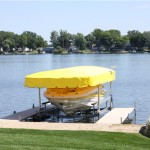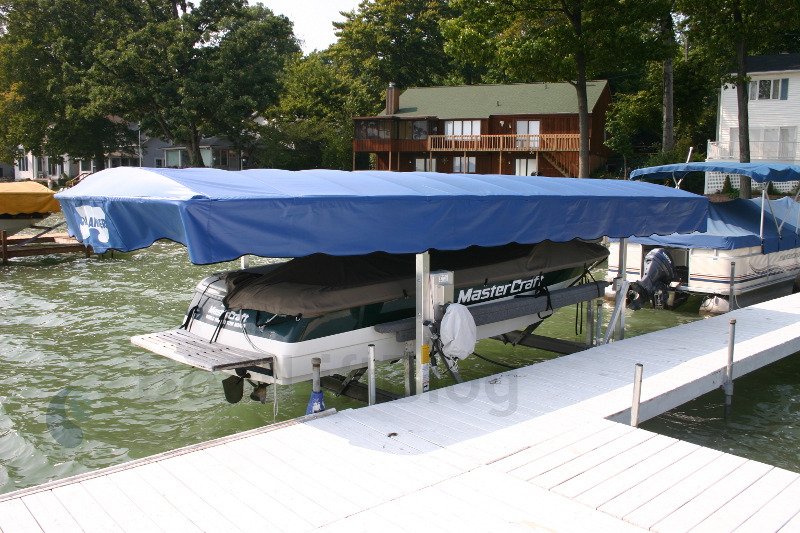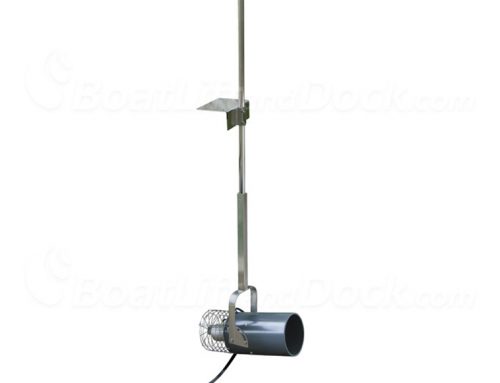Seasonal Boat Lift Care
 The air is getting cooler and the days shorter and as the leaves change and drift to the ground we accept that the season is drawing to a close. As much as we may wish for just one more, sunny weekend to get out on the water, the turning earth has other plans and those nice fall weekends are disappearing fast. Winter will be here soon and there are a few housekeeping chores to take care of that will make next season all that it should be. If you have a boat lift without additional accessories such as a canopy, boat lift motor, or a solar charging kit, then your job is to simply get the lift up on shore where it will be safe from ice flow. However, if you do have some or all of these accessories then you should take care to remove and store these before the weather shifts.
The air is getting cooler and the days shorter and as the leaves change and drift to the ground we accept that the season is drawing to a close. As much as we may wish for just one more, sunny weekend to get out on the water, the turning earth has other plans and those nice fall weekends are disappearing fast. Winter will be here soon and there are a few housekeeping chores to take care of that will make next season all that it should be. If you have a boat lift without additional accessories such as a canopy, boat lift motor, or a solar charging kit, then your job is to simply get the lift up on shore where it will be safe from ice flow. However, if you do have some or all of these accessories then you should take care to remove and store these before the weather shifts.
Here we will cover the basics of canopy care and in related articles we will address the care of your boat lift motor, solar charging kit, and batteries; as well as the proper maintenance of your lift cables. This series of articles is intended to give you a working knowledge of your lift and also give you the knowledge you need to extend the life of your lift.
Canopy and Canvas Care
 Before you determine the best way to clean and store your boat lift canopy, it should be mentioned that there are services available that will do it for you. The cost of such service varies and we will leave it to you to determine if this is the way you wish to go. If not, then the cleaning and proper storage of your canopy will require some basic supplies and steps to ensure the longevity of you cover. The first step is to ensure that any product that you use is safe for your canopy material and does not contain any ingredients that will stain, corrode, or otherwise damage the material.
Before you determine the best way to clean and store your boat lift canopy, it should be mentioned that there are services available that will do it for you. The cost of such service varies and we will leave it to you to determine if this is the way you wish to go. If not, then the cleaning and proper storage of your canopy will require some basic supplies and steps to ensure the longevity of you cover. The first step is to ensure that any product that you use is safe for your canopy material and does not contain any ingredients that will stain, corrode, or otherwise damage the material.
Vinyl Canopy Cleaning
If you have a vinyl canopy cover then the cleaning and storage of the canopy will require that you first remove the canopy from the lift. Once removed, spread the canopy out on a flat clean surface; grass is fine but you should avoid damp or freshly mowed areas as this may increase the work you end up doing. Use a vinyl cleaner, that is recommended for your material, or, better and safer yet, use warm, soapy water and a soft bristled brush to gently clean the surface. Rinse well and allow the canopy to dry. Once the material has thoroughly dried you may want to apply a vinyl protectant with a cloth or paper towel and allow this to dry as well. Before applying any chemical cleaner or protectant to your canopy, you should do your homework. Contact the manufacturer or a dealer and inquire about the proper product to use.
Canopy Storage
 To store the canopy, carefully fold the canopy in on itself several times until it resembles a strip 18”-24” wide and then roll the canopy into a roll that is manageable. Many canopies will come with their own storage bag but if yours did not, take care not to store the canopy in a plastic or otherwise un-breathable material. The canopy should be allowed to “rest” in a protective bag or box that allows for proper air movement. If the bag does not allow the canopy to breathe, then moisture could accumulate and promote molds and mildew in the off season, ultimately making your canopy’s life-span shorter. The stitching and seams that hold your canopy together should be kept as clean and dry as possible to avoid the failure of these areas from exposure to moisture, mold and dry-rot as the years roll by.
To store the canopy, carefully fold the canopy in on itself several times until it resembles a strip 18”-24” wide and then roll the canopy into a roll that is manageable. Many canopies will come with their own storage bag but if yours did not, take care not to store the canopy in a plastic or otherwise un-breathable material. The canopy should be allowed to “rest” in a protective bag or box that allows for proper air movement. If the bag does not allow the canopy to breathe, then moisture could accumulate and promote molds and mildew in the off season, ultimately making your canopy’s life-span shorter. The stitching and seams that hold your canopy together should be kept as clean and dry as possible to avoid the failure of these areas from exposure to moisture, mold and dry-rot as the years roll by.
If your canopy is made of fabric such as acrylic, cloth, or other materials, the care and storage will follow the stages outlined above. Clean the material with the proper cleaner or warm, soapy water, allow to dry, treat it with an approved protectant and store in a breathable bag or box in a cool, dry place. You should avoid, if possible, binding the canopy for storage and never use duct tape to keep the canopy bundle together as the glues used are difficult to remove. Binding the canopy for long periods could promote intense creasing that may eventually lead to splitting of the canvas. The attaching materials: bungees, springs, cords, straps, etc., should be stored in a separate bag and kept with the canopy to avoid misplacement of the attaching hardware and unintended damage to the canopy by these items.






